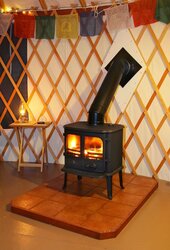I am hoping there will be someone who can help me troubleshoot the lack of heat output from my new Morso 2110. I replaced an old Lange stove just recently with the Morso.
The dealer set me up with some very nice 6" insulated stovepipe which I installed with the stove. There is about 2' of stovepipe exiting the top of the stove, an elbow, then into the insulated thimble. The thimble empties into a clay lined chimney.
Having spent the weekend experimenting with my new stove, I was disappointed to find that it would not throw heat! The external thermometer showed the top plate of the stove reaching 500-550F but you had to be within 2' of the thing to feel the warmth! The old Lange would bake an acorn squash at 6'! (it felt like it would) A thermometer placed about twelve feet away in our 12x20 Kitchen wouldn't break 62F this weekend.
Not having very much experience with the newer, more efficient stoves, I think that my heat is going up the chimney. I have a very, very strong draft in my chimney. Once the fire is started and thoroughly underway, I close down the primary air inlet. The secondary inlet (which cannot be adjusted) lets air in at just short of a whistle. I can see the air moving very briskly through the fire? Even with a 2" thick bed of cherry red coals and 2 good size logs blazing, the kitchen does not warm up. Where is all the heat going? The same fire in the Lange would have heated the house!
Given this scenario, does anyone have any thoughts on my situation?
The dealer set me up with some very nice 6" insulated stovepipe which I installed with the stove. There is about 2' of stovepipe exiting the top of the stove, an elbow, then into the insulated thimble. The thimble empties into a clay lined chimney.
Having spent the weekend experimenting with my new stove, I was disappointed to find that it would not throw heat! The external thermometer showed the top plate of the stove reaching 500-550F but you had to be within 2' of the thing to feel the warmth! The old Lange would bake an acorn squash at 6'! (it felt like it would) A thermometer placed about twelve feet away in our 12x20 Kitchen wouldn't break 62F this weekend.
Not having very much experience with the newer, more efficient stoves, I think that my heat is going up the chimney. I have a very, very strong draft in my chimney. Once the fire is started and thoroughly underway, I close down the primary air inlet. The secondary inlet (which cannot be adjusted) lets air in at just short of a whistle. I can see the air moving very briskly through the fire? Even with a 2" thick bed of cherry red coals and 2 good size logs blazing, the kitchen does not warm up. Where is all the heat going? The same fire in the Lange would have heated the house!
Given this scenario, does anyone have any thoughts on my situation?


